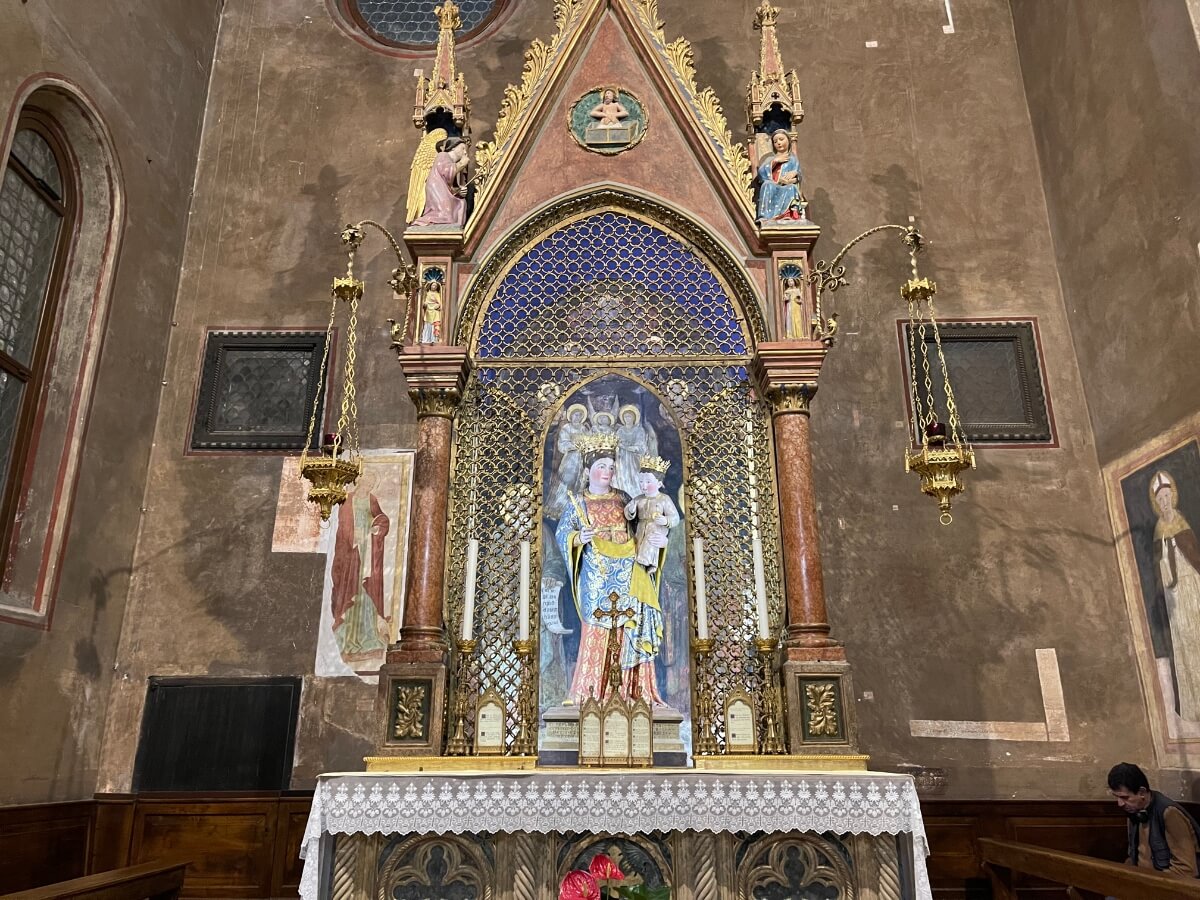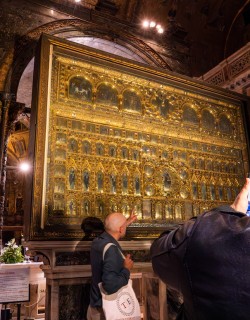At under an hour away from Venice, Padua makes an ideal day trip from the Floating City. Boasting a beautifully preserved medieval city centre centred around Italy’s second-oldest university, there is no shortage of things to do in this lively city. From Giotto’s era-defining frescoes in the Scrovegni Chapel that helped usher in the Renaissance revolution in Western art to one of Europe’s oldest and vibrant markets, a mouth-watering foodie culture and much more, you’ll be sure to fall in love with Padua. When in town, one of the highlights that you need to see is the soaring Basilica of Saint Anthony. A treasure trove of masterful art, spectacular architecture and spirituality dedicated to the city’s patron saint, it’s easy to while away a few spellbound hours in the massive church known to locals simply as ‘Il Santo.’ Read on for a guide to the church, and discover what to see in Padua’s Basilica of Saint Anthony!
History: Saint Anthony and Padua

The beautiful north Italian city of Padua is synonymous with its rockstar patron saint, Anthony. Despite his deep association with the Veneto, the globally popular Anthony was not actually a native of Padua or even Italy, hailing instead from the Portuguese capital of Lisbon. Born into a wealthy family in 1195 as Fernando Martins de Bulhões, the future saint joined the Augustinian order at the age of 15 before being won over by the simpler life of the recently founded Franciscan movement. Adopting the name of Anthony, after various misadventures he ended up in Italy, where he soon gained renown as an impressive preacher and orator. Rising to the rank of Provincial superior for the Franciscans in Northern Italy, Anthony moved to Padua, where he founded a convent before dying in 1231 just outside the city at the tender age of 36. The exact cause of the saint’s death is unknown, but some have theorised that his illness was the result of ergot poisoning contracted from eating contaminated wheat, or alternatively from fluid retention around his heart.
Architecture: Medieval Fusion

In keeping with the vows of humility and poverty associated with the Franciscan order, Anthony was buried in the unassuming church of Santa Maria Mater Domin that he had himself founded in what was then the city’s outskirts. As with the order’s founder St. Francis, however, Anthony’s rapidly increasing fame and veneration (miraculous happenstances were soon recorded to have taken place at the site of his grave, and he was canonised just a year after his death) meant that plans were soon made to transform his resting place into something altogether grander: work began on a new basilica in 1232, and it would take almost 70 years to complete the massive church that dominates the city today, known simply as ‘Il Santo’ (the saint).
The enormous basilica of Saint Anthony is architecturally fascinating, a complex mix of styles that defies easy description. The impressive and somewhat forbidding brick exterior is Romanesque in character, but the series of domes surmounting the church are wholly Byzantine - here the influence of St. Mark’s basilica in Venice is obvious. The interior of the church, meanwhile, takes us into the Gothic age with its series of nine chapels radiating outwards from the apse and high pointed arches recalling the great cathedrals of medieval France. A series of beautiful cloisters open off from the basilica, little oases of calm full of the meditative spirit of Franciscanism.
Art: Treasures of the Basilica of Saint Anthony

The interior of the church takes the form of a massive Latin cross, with chapels leading off a central nave and side aisles, a wide transept and an ambulatory surrounded by radial chapels. Each of the chapels is worth a look, but what follows are the unmissable highlights.
Main Altar
 The main altar of the church features a series of 29 bronze sculptures by Donatello - the basilica’s absolute artistic masterpieces. Known as the Altare del Santo, the group includes free-standing portrait sculptures of various saints including Anthony and Francis as well as bas reliefs portraying Anthony’s miracles. Surmounting everything is the artist’s incredibly moving crucifix. Unfortunately Donatello’s original arrangement of these works is unknown, as the altar was taken apart in the 16th century and speculatively rearranged in the late 1800s.
The main altar of the church features a series of 29 bronze sculptures by Donatello - the basilica’s absolute artistic masterpieces. Known as the Altare del Santo, the group includes free-standing portrait sculptures of various saints including Anthony and Francis as well as bas reliefs portraying Anthony’s miracles. Surmounting everything is the artist’s incredibly moving crucifix. Unfortunately Donatello’s original arrangement of these works is unknown, as the altar was taken apart in the 16th century and speculatively rearranged in the late 1800s.
Chapel of the Relics

Wander around the high altar to access the nine chapels that radiate off it, including the Baroque Cappella delle Reliquie (Chapel of the Relics) on the right, where the precious corporeal relics of Saint Anthony himself draw pilgrims from around the world. The setting is a seriously impressive confection of gold and precious jewels, and the the bewildering array of relics include the saint’s humble habit, his tongue, whose fluent oratory won him so many admirers in life, as well his jawbone, cartilage from his larynx, and vocal chords .
Chapel of the Dark Madonna

Although much reduced, the original church of Santa Maria Mater Domini remained the centrepiece around which the new basilica unfolded, transformed into a chapel known as the Capella della Madonna Mora, or Chapel of the Dark Madonna. Anthony’s tomb was here until 1263, and the stunning Gothic altar is graced by a lovely 14th-century statue of the Virgin and Child sculpture by French artist Renauldin of Gascony. Behind the altar, a fragmentary fresco recently attributed to Giotto constitutes the first work by the master in Padua, a prelude to his era-defining work in the nearby Scrovegni chapel.
The Chapel of the Blessed Luke

Pass by Renauldin’s sculpture to enter the The Chapel of the Blessed Luke, dedicated to one of Anthony’s closest companions and disciples. Here the walls are adorned with masterful 14th-century frescoes by the Florentine painter Giusto de Menabuoi, paintings rich in colourful detail. Giusto was also responsible for the medieval decorations of the Baptistery of Padua Cathedral - another must-visit when in the city.
Cappella del Santo
 Leading off the left transept is the Cappella del Santo, or Chapel of Saint Anthony: here Anthony’s sepulchre, created in 1594 by Tiziano Aspetti, occupies pride of place in a spectacular Renaissance interior framed by a splendid marble colonnade, the work of the Lombardi brothers. The saint’s tomb is covered in entreaties for intercession and notes of thanks written by the faithful, who queue up to place their hands on the sarcophagus.
Leading off the left transept is the Cappella del Santo, or Chapel of Saint Anthony: here Anthony’s sepulchre, created in 1594 by Tiziano Aspetti, occupies pride of place in a spectacular Renaissance interior framed by a splendid marble colonnade, the work of the Lombardi brothers. The saint’s tomb is covered in entreaties for intercession and notes of thanks written by the faithful, who queue up to place their hands on the sarcophagus.

The artistic highlights of the chapel are nine incredible Renaissance sculptures carved in high relief depicting the life and miracles of Anthony, the work of various master craftsmen in the opening decades of the 16th century. Look out for Antony reviving corpses, reattaching dismembered limbs, reconciling jealous husbands and, in our favourite scene, carving open the body of a miser to demonstrate that the thrifty deceased had no heart and was undeserving of Christian burial.
Chapel of Saint James

Facing the Capella del Santo on the right hand side of the nave is the 14th-century Gothic chapel of Saint James featuring marvellous frescoes by Altichiero da Zevio, including an illusionistic scene depicting the Crucifixion that is decades ahead of its time. Altichiero’s deep grasp of human psychology and ability to depict emotion makes him one of the foremost painters of the 1300s, and this might just be his masterpiece. Look out for a fresco depicting another of Saint Anthony’s most memorable miracles, when the silver-tongued religioso preached the word of god to an awe-struck fish (like St. Francis, Anthony was a big hit with animals).
Just outside the basilica, the Oratory of St. George also features masterful fresco cycles by Altichiero da Zevio. For more, read our guide to the most important sites you need to see in Padua.
Through Eternity offer customised tours of Padua led by expert local guides - if you’re planning a visit to this fascinating medieval city or would like to organise a day-trip from Venice, then be sure to check out our Best of Padua tour or get in touch with our travel experts to arrange a bespoke itinerary!




